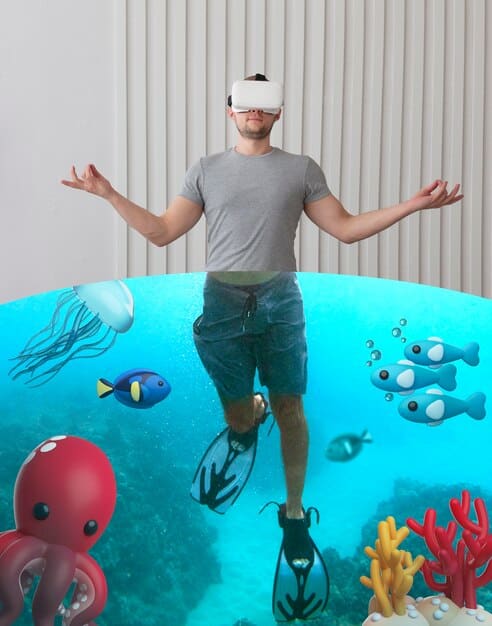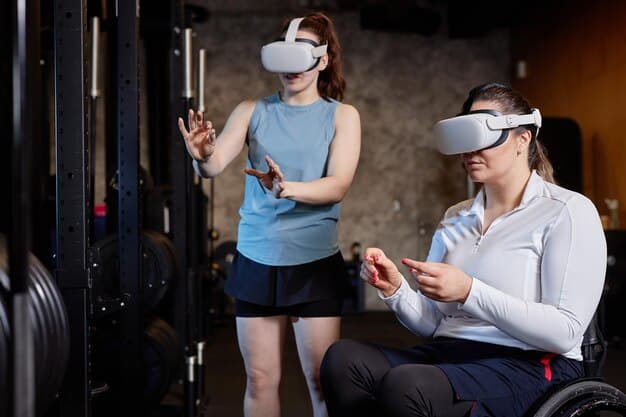VR-Powered Healthcare: Enhancing Patient Outcomes by 20% with VR Therapy

VR-Powered Healthcare leverages virtual reality technology to create immersive therapeutic programs, with the potential to improve patient outcomes by up to 20% through innovative and engaging treatment methods.
Are you ready to revolutionize healthcare? VR-Powered Healthcare: Improve Patient Outcomes by 20% with VR Therapy Programs is no longer a futuristic fantasy. It’s a present-day reality, transforming how we approach patient care and deliver tangible improvements.
The Dawn of VR-Powered Healthcare
Virtual Reality (VR) is stepping out of the gaming world and into the healthcare sector, promising a wave of innovative solutions. From pain management to rehabilitation, the applications are vast and the potential impact on patient outcomes is significant.
We’re not just talking about incremental improvements. VR-powered therapy programs are showing promise in delivering a 20% improvement across various metrics, revolutionizing how treatments are administered and how patients experience healthcare.

VR in Pain Management
One of the most promising areas of VR applications in healthcare is pain management. VR can create immersive environments that distract patients from pain stimuli, effectively reducing their reliance on traditional medication.
Chronic pain sufferers often find themselves trapped in a cycle of medication and discomfort. VR offers a non-pharmacological alternative to manage pain and improve the overall quality of life.
- Reduced reliance on opioids and other pain medications
- Enhanced patient comfort during medical procedures
- Improved psychological well-being through distraction and relaxation
- Long-term pain management strategies through immersive therapy
Studies have demonstrated that VR therapy can significantly reduce pain levels in patients undergoing various medical procedures, from wound care to chemotherapy treatments. The immersive nature of VR helps to create a powerful distraction, allowing patients to focus on the virtual world rather than their pain.
VR for Physical Rehabilitation
VR-powered rehabilitation programs are changing the landscape of how patients recover from physical injuries and surgeries. By creating engaging and interactive environments, patients are motivated to actively participate in their recovery process.
Traditional physical therapy can often be monotonous and challenging, leading to reduced patient compliance. VR introduces an element of gamification, making the rehabilitation process more enjoyable and effective.
Enhancing Motor Skills
VR provides a safe and controlled environment for patients to practice motor skills. The system can track their movements and provide real-time feedback, enabling them to refine their techniques and improve their coordination.
Whether it’s recovering from a stroke or a traumatic brain injury, VR rehabilitation can help patients regain lost motor skills at a faster pace.

Promoting Engagement
- Increased patient motivation through gamified exercises
- Personalized therapy programs tailored to individual needs
- Real-time feedback and progress tracking
- Improved adherence to rehabilitation protocols
Applications in Mental Health
VR is proving to be a powerful tool in mental health treatment. From anxiety disorders to PTSD, VR therapy provides a safe and controlled environment for patients to confront their fears and work through their traumas.
Exposure therapy, a common treatment for anxiety disorders, can be particularly effective when combined with VR. Patients can gradually expose themselves to feared situations in a virtual environment, reducing their anxiety levels without the real-world risks.
Treating PTSD
VR has shown promise in treating Post-Traumatic Stress Disorder (PTSD) by recreating traumatic events in a controlled setting. This allows patients to confront their memories and process their emotions in a safe environment, ultimately reducing the symptoms of PTSD.
The immersive nature of VR allows for a more intense and realistic exposure, which can lead to faster and more effective treatment outcomes.
Addressing Phobias
- Effective treatment for a variety of anxiety disorders
- Safe and controlled exposure to feared situations
- Improved coping mechanisms and reduced anxiety levels
- Personalized therapy programs tailored to individual needs
VR therapy can also be effective in treating phobias. Patients can confront their fears in a virtual environment, gradually building confidence and reducing their anxiety levels.
The Technology Behind VR Healthcare
The success of VR-powered healthcare relies on advanced technology that simulates realistic and engaging environments. High-resolution displays, motion tracking sensors, and haptic feedback devices all play a crucial role in creating a truly immersive experience.
Moreover, specialized software and content are required to deliver targeted therapeutic interventions. The development of these programs requires a collaborative effort between healthcare professionals, software developers, and content creators.
Hardware and Software
The hardware used in VR healthcare typically includes VR headsets, motion tracking sensors, and haptic feedback devices. The software consists of specialized programs that simulate realistic environments and deliver targeted therapeutic content.
Advancements in hardware and software are constantly improving the capabilities of VR in healthcare. As technology evolves, VR will become even more realistic, immersive, and effective.
- High-resolution displays for realistic visuals
- Accurate motion tracking for natural interactions
- Haptic feedback for tactile sensations
- Specialized software for targeted therapeutic interventions
Challenges and Considerations
Despite the vast potential of VR-powered healthcare, there are challenges and considerations that need to be addressed. Cost, accessibility, and usability are among the key factors that need to be taken into account.
The initial investment in VR equipment and software can be substantial, potentially limiting its accessibility to smaller healthcare providers and patients with limited resources. However, as technology becomes more affordable, wider adoption is expected.
Cost and Accessibility
The cost of VR equipment and software can be a barrier to entry for many healthcare providers. Additionally, the technology may not be readily accessible to patients in rural or underserved areas.
However, as technology becomes more affordable and accessible, VR healthcare is expected to become more widely adopted across the healthcare landscape.
Usability and Training
- Cost of equipment and software
- Accessibility in rural and underserved areas
- Usability for patients with limited technical skills
- Training requirements for healthcare professionals
The usability of VR technology is another important consideration. Some patients, particularly older adults, may find it challenging to use VR headsets and navigate virtual environments. Healthcare professionals also need to be trained on how to effectively use VR therapy programs.
The Future of VR in Healthcare
The future of VR in healthcare is bright, with ongoing research and development pushing the boundaries of what’s possible. As technology continues to improve and become more affordable, VR is expected to play an even greater role in transforming patient care.
From remote monitoring to personalized therapy, the applications of VR are limitless. We’re only beginning to scratch the surface of what VR can do for healthcare.
Emerging Trends
Several emerging trends are shaping the future of VR in healthcare. These include the use of artificial intelligence (AI) to personalize therapy programs, the development of new VR content for various medical conditions, and the integration of VR with other technologies, such as telehealth.
As these trends continue to evolve, VR will become an increasingly integral part of the healthcare ecosystem.
- Personalized therapy programs using AI
- New VR content for various medical conditions
- Integration of VR with telehealth platforms
- Remote patient monitoring and support
VR-powered healthcare is not just a passing trend. It’s a transformative technology that has the potential to improve patient outcomes and revolutionize the way we approach healthcare. By embracing VR, we can create a future where healthcare is more effective, engaging, and accessible for everyone.
| Key Point | Brief Description |
|---|---|
| 💡 VR in Pain Management | Reduces reliance on medication through immersive distraction. |
| 💪 VR for Rehabilitation | Enhances motor skills and engagement with gamified exercises. |
| 🧠 VR in Mental Health | Treats anxiety and PTSD with safe, controlled exposure therapy. |
| 🚀 Future Trends | AI personalization and telehealth integration for VR therapy. |
FAQ
VR-powered healthcare utilizes virtual reality technology to create immersive and interactive therapeutic programs. These programs aim to improve patient outcomes by providing engaging and effective treatment methods for various medical conditions.
VR helps in pain management by creating immersive environments that distract patients from pain stimuli. This distraction can significantly reduce the reliance on traditional pain medications and improve overall patient comfort during medical procedures.
VR plays a crucial role in physical rehabilitation by providing engaging and interactive environments for patients to practice motor skills. It personalizes therapy programs, tracks progress, and promotes adherence to rehabilitation protocols, resulting in faster recovery.
Yes, VR is a powerful tool in mental health treatments. It provides a safe and controlled environment for patients to confront fears and work through traumas. It treats anxiety disorders, PTSD, and phobias with effective exposure therapy.
Challenges of VR in healthcare include the cost of equipment and software, limited accessibility in rural areas, and usability issues for patients with limited technical skills. Training healthcare professionals to use VR therapy programs is also essential.
Conclusion
VR-Powered Healthcare: Improve Patient Outcomes by 20% with VR Therapy Programs presents a groundbreaking approach to modern medicine. By harnessing the power of virtual reality, we can create immersive therapeutic experiences that significantly enhance patient outcomes. As the technology evolves and becomes more accessible, it’s poised to revolutionize the healthcare landscape, offering innovative solutions for pain management, rehabilitation, mental health, and more.





